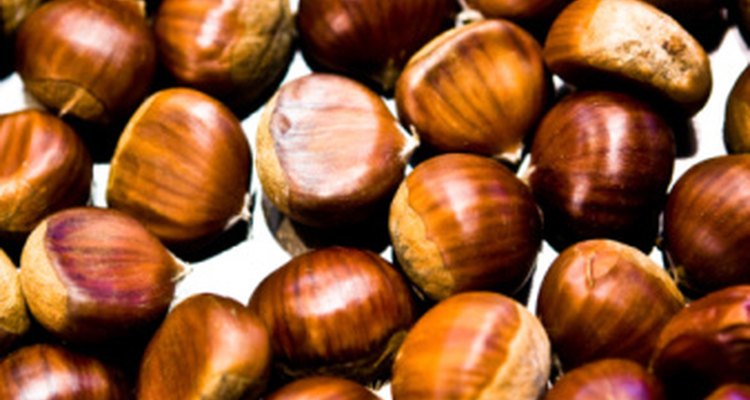
Buckeyes and chestnuts are not the same, though they do look alike. Buckeyes and American chestnuts are native to the United States, but other chestnuts, including the horse chestnut, are imported. All three trees are impressive with their stature, large leaves, clusters of white or yellow flowers and odd fruit. The shiny seeds are wrapped in prickly green pods.
Buckeye
The Ohio buckeye is the best known buckeye. It grows from the western face of the Appalachian mountains through the Ohio and Mississippi valleys. It grows slowly and up to 70 feet tall. The flowers are creamy yellow, appearing in the early part of June. By late summer you can see the fruit. They are green, thick and covered with small prickly spikes. Inside is one seed. It is brown and looks like it has been polished. The tree turns yellow and orange in autumn. It is easy to spot the tree in winter when it shows pairs of scaly dark brown buds.
American Chestnut
Colonial Europeans arriving in what became the United States found vast forests of hardwood including American chestnut. Today these tree populations have been greatly reduced by fungal blight. The seeds inside the pods are flatter than the buckeyes and more teardrop shaped than elliptical. The leaves are tooth-edged. Their color is pale, yellow green. By autumn the leaves are yellow. American chestnuts can reach 100 feet tall.
Horse Chestnut
The horse chestnut came from Greece and is found around the world as a shady ornamental. The flowers in spring are impressive. The upstanding clusters making the tree look like a version of a Christmas tree with candles. The white panicles can be as large as 12 inches when they bloom in late spring. The buds of horse chestnut are shiny, quite large and resinous. Horse chestnuts can grow to 50 feet.
Differences
Buckeyes have only one fruit in the pod. Chestnuts usually have two or three. Horse chestnuts usually have one fruits in the pod. The pod of the American chestnut has a thicker growth of hairlike spikes on the outside. Horse chestnut and buckeyes have a shiny pod with fewer, bumpy spikes. Buckeye trees have fans of five leaves while American and horse chestnut leaves are spans of six or seven. Horse chestnut leaves are much larger than buckeyes or American chestnuts.
Edibles
Only true chestnuts are edible. Native Americans and early European settlers ate chestnuts as people in Europe and Asia had done for thousands of year. The majority of chestnuts available for consumption today are imported from Europe, especially Italy. They are used for roasting, made into flour and used for pastry filling. Ohio buckeye nuts are not edible. Buckeye seeds have a disagreeable taste and are said to be poisonous, although hogs can and do enjoy them occasionally. Horse chestnuts are not edible.
Related Articles
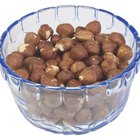
What Kinds of Nuts Don't Grow on Trees?

Types of Edible Hickory Nuts
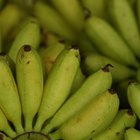
List of Tropical Fruits

Fruits or Vegetables Starting With X

Types of Quince Trees

The History of Butternut Squash

List of Wild Edible Plants & Berries in ...

How to Tell If My Tomatillos Are Ripe
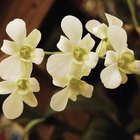
The Meaning of a White Orchid
When Is Grapefruit Season in Florida?

What Plant Do Caraway Seeds Come From?
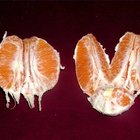
Information About the Orange Fruit
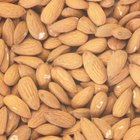
Types Of Almonds
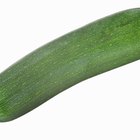
Calories in a Large Zucchini

Types of Greek Fruits & Vegetables
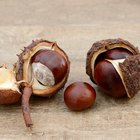
How to Preserve Buckeye Nuts
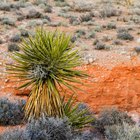
Fruits or Vegetables That Start With Y

Places to Pick Wild Blueberries in ...
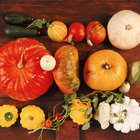
What Is White Squash?

Can You Eat the Green Stem of a ...
References
Writer Bio
Roz Calvert was a contributing writer for the award-winning ezine Urban Desires where her travel writing and fiction appeared. Writing professionally since 1980, she has penned promotional collateral for Music Magnet Media and various musicians. The "Now Jazz Consortium" published her jazz educational fiction. She published a juvenile book about Zora Neale Hurston and attended West Virginia University and the New School.
Photo Credits
Jupiterimages/Photos.com/Getty Images